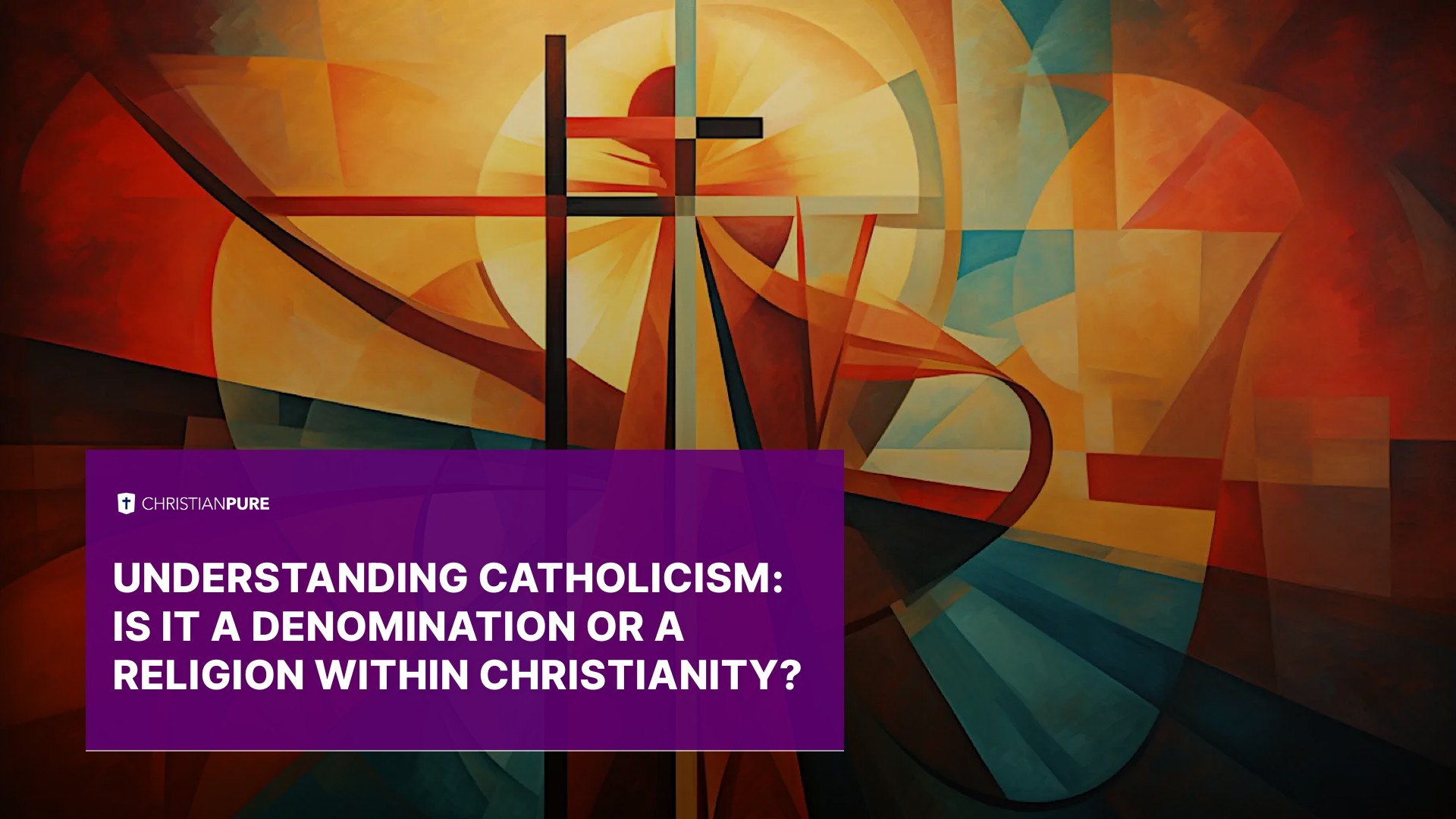What Is a Christian Denomination?
As a storyteller, let me take you on a journey of understanding Christian denominations. Picture yourself walking through a forest, where each tree represents a different belief system. In this forest, a Christian denomination would be a distinct tree, identified by its unique characteristics; its name, history, organizational structure, leadership, doctrine, and worship style, but sharing the same soil and sunlight. These distinct trees, each with their characteristic attributes, together form the magnificent forest of Christianity.
A denomination within Christianity, then, can be thought of as a recognized autonomous branch, akin to a tree with its roots in the same spiritual soil. Like trees in a forest, all denominations draw nourishment from the fundamental faith in Jesus Christ, but in their own unique ways, through their distinct theologies and practices.
This deference in worship style, doctrine, or even leadership doesn't make any denomination superior or inferior; similarly to different species of trees, each stands tall and robust in its own light. This is beautifully represented by the concept of denominationalism. A belief that underscores the assertion that all Christian bodies, irrespective of their variations in labels, dogmas, or practices, are legitimate branches of the same religious tree.
It is worth noting though, that while all Christian denominations share some fundamental beliefs, their interpretation and implementation can considerably vary. From the monastic mysticism of the Orthodox Church, the hierarchical structure of Catholicism, the evangelical passion of Protestant denominations to the Latter-Day Saints' focus on modern revelation, these variations add to the richness and diversity of Christian expression.
Drawing from this forest analogy, denominations run the risk of overlooking the shared spiritual ground beneath their distinctive identities. Yet, it is precisely these differences that give Christianity its wonderful diversity, like a vibrant, ever-changing forest, always growing and evolving.
- A Christian denomination is an autonomous branch characterized by distinct traits such as name, history, organization, leadership, doctrine, and worship style.
- All Christian denominations share the fundamental belief in Jesus Christ but exhibit unique interpretations and expressions of this shared faith.
- Denominationalism asserts the legitimacy and mutual respect of all Christian groups, regardless of their distinct characteristics.
- The variety in Christian denominations contributes to Christianity's rich diversity, akin to different species of trees within a forest.
Is Catholicism a Denomination of Christianity?
It can be challenging to perceive the comprehensive structure of Christianity, especially with its numerous spiritual pathways that believers walk, adding to its rich diversity.
Catholicism, dear reader, holds an eminent place in this vast landscape as a central pillar to Christianity's monumental edifice. It is indeed a denomination, one of the most significant divisions of Christianity, which beautiful mosaic also embraces Orthodoxy and Protestantism in its grand design. To comprehend fully the profound truth of this assertion, one must delve into the essential doctrines that Catholicism distinctly upholds.
When we speak of Catholicism, we talk of a faith that reveres the Pope as not merely a spiritual leader but the successor to Christ on earth. This belief in Papal authority and apostolic succession delineates Catholicism and is a core distinction from other Christian denominations, which do not uphold this belief. The Roman Catholic Church, one of Catholicism's most visible divisions, claims millions of followers worldwide devoted to its teachings based on the life of Jesus Christ as recorded in the Holy Bible.
The Catholic Church considers its interpretation of the Christian faith as truest to Jesus Christ's original teachings, making it a pathway that it believes carries the most precise spiritual compass to salvation. Despite the various denominations under the Christian banner, the Catholic Church views these other branches as having deviated from the main path of unadulterated Christian faith.
To use an analogy, if Christianity is a vast tree, Catholicism is a significant branch of that tree, along with Orthodoxy and Protestantism. Each branch bearing its distinctive leaves, fruit, and flowers – respectively embodying their unique belief systems, yet ultimately, they belong to the same tree rooted in the teachings of Jesus Christ.
Summary:
- Catholicism is indeed a denomination of Christianity, a significant branch alongside Orthodoxy and Protestantism.
- Catholics uphold the belief in the Papal authority, affirming that the Pope is the successor to Jesus Christ, which marks a distinctive doctrinal difference from other Christian denominations.
- The Roman Catholic Church is an important division within Catholicism, with millions of followers worldwide committed to its teachings based on Jesus Christ as recorded in the Bible.
- The Catholic Church believes that its interpretation of Christian faith is the most accurate, viewing other Christian denominations as offshoots that have deviated from core Christian teachings.
Why do some consider Catholicism a separate religion and not a denomination of Christianity?
Some people consider Catholicism to be a separate religion rather than a denomination of Christianity due to the significant differences in beliefs and practices as compared to other Christian sects. One key contention surrounds the concept of Papal Supremacy, where the Pope is recognized as the leader of the global Catholic Church and vested with the authority to make decisions that bind all Catholics. This concept, central to Catholicism, is not accepted by most other Christian denominations.
Another aspect that might lead to the classification of Catholicism as a separate religion is the body of catholic teachings and rituals that, while incorporated into Catholic doctrine, are not explicitly detailed in the Bible. These encompass holy traditions such as the canonization of saints, the veneration of Mary, the concept of Purgatory, and a sacramental understanding of grace, among others. For many non-Catholic Christians, these elements diverge from their own understanding of biblical Christian Beliefs, which adheres more strictly to the plain text of the Bible.
The Catholic Church's assertion that it is the original Christian Churchand its claim to authority over all other Christian denominations also factor into this perspective. The Catholic Church maintains that other branches of Christianity have deviated from the truth of Jesus Christ as revealed to the apostles, and consequently have an incomplete understanding of Christianity. This perspective is not shared by most other Christian denominations, an aspect that further distinguishes Catholicism from them.
These differences do not inherently invalidate Catholicism's place within Christianity, however. Given that Catholicism recognises Jesus Christ as its central figure and subscribes to the Nicene Creed, a unifying statement of faith shared across most Christian denominations, Catholicism is generally recognised as part of the broader Christian faith despite its unique features.
Summary:
- The Catholic belief in papal supremacy is a key aspect that distinguishes it from other Christian denominations, leading some to view it as a separate religion.
- Catholicism includes teachings and practices not explicitly detailed in the Bible, which diverge from the interpretation of biblical Christianity held by many non-Catholic Christians.
- The Catholic Church's assertion of authority over other Christian Churches and its claim to be the original Christian Church contribute to the perspective of Catholicism as a separate religion.
- Despite these distinctions, Catholicism's recognition of Jesus Christ as its central figure and its adherence to the Nicene Creed generally place it within the broader framework of Christianity.
Is there a difference between Roman Catholic and other types of Catholicism?
The Roman Catholic Church, the most prominent face of Catholicism, holds an unwavering belief in Papal supremacy, meaning the Pope, situated in Vatican City, is considered the earthly representative of Christ, with ultimate authority in matters of faith and church discipline. This is a concept not found, or at times, staunchly rejected, in other branches of Catholicism, like the Old Catholic Church or Eastern Catholic Churches. Further, distinct forms of liturgical worship, different views on certain teachings, and historical nuances differentiate these branches from Roman Catholicism.
To paint a picture with a broader brushstroke, Eastern Catholic Churches, although recognizing papal authority, lean towards practicing their faith with Byzantine rites, while the Roman Catholic Church remains faithful to the Latin rites. The Old Catholic Church, on the other hand, severed ties with Papal authority after the dogma of Papal Infallibility was pronounced in the 19th century.
Then there are Independent Catholic Churches that are not in full communion with Rome, becoming home to many who seek the familiarity of Catholic customs, yet prefer to wander off the stringent path of traditional dogmas. These churches often exhibit a more liberal approach, such as allowing women priests and married clergy, which is not the norm in Roman Catholicism.
My dear reader, in the words of poet Rumi, even in the singular term 'Catholic', there are 'a thousand ways to kneel and kiss the ground', as each branch, each expression of Catholicism, passionately kneels before the Divine Mystery. Yet, despite their differences, they all bloom from the same root, that of universal love and adherence to the teachings of Jesus Christ.
Summary:
- Roman Catholicism is characterized by a strong belief in Papal supremacy, which may not be equally relevant in other branches of Catholicism.
- Eastern Catholic Churches, while recognizing Papal authority, tend to practice Byzantine rites, adding to their unique identity within the grand tapestry of Catholicism.
- The Old Catholic Church, in a sharp departure from Roman Catholicism, does not accept Papal Infallibility, marking one of the significant theological dichotomies.
- Independent Catholic Churches often adopt more liberal stands on certain traditional dogmas, validating the spectrum of beliefs that exist under the Catholic umbrella.
Are all Catholics considered Christians?
Yes, indeed, all Catholics are Christians. Now, this might seem like an overly simplified utterance, but believe me, it bears enormous weight and significance. Christianity, with all its mystery and beauty, encompasses several branches and hues, one of the most significant being Catholicism. Catholicism fits snug in the kaleidoscope of Christianity, adding its own color and individuality, yet firmly remaining part of the broader spectrum.
As I delve deeper into this eternal inquiry, I cannot help but be amazed by the depth and breadth of this spiritual voyage. Catholicism, a division of Christianity, stands proudly with Orthodoxy and Protestantism, like sturdy pillars supporting the grand edifice of Christian faith. In that sense, all Catholics, by being part of this grand church, share the boundless love of Christ and His teachings.
Yet, Catholicism, in its pursuit of faith, treads a distinct path. Yes, the destination might be similar, but the journey is unique, accentuated with interpretations and rituals that resonate with the Catholic ethos. Does this journey make them anything but Christians? Certainly not, for all roads lead to the same Creator, and all modes of worship are varied expressions of the same divine love.
Catholicism's stirrings trace back to the times of Jesus and the apostles, the foundational stage of Christianity itself. Thus, to be a Catholic is inherently to be a Christian. However, the converse may not always hold true, for Christianity is an expansive realm, playing host to various other denominations.
So, let me reiterate, all Catholics are Christians, for they have been born in His grace and have grown in His love. Their faith, while following the distinct path of Catholicism, effortlessly converges with the essence of Christianity. It's like streams merging into the mighty river, distinct yet one. That, dear reader, is the beauty of this faith, the magic of this spiritual confluence.
Summary:
- All Catholics are Christians, but not all Christians are Catholics.
- Catholicism is a significant division of Christianity, which also includes Orthodoxy and Protestantism.
- Distinct interpretations and rituals within Catholicism do not separate Catholics from the Christian faith; instead, they add to the diversity and depth of the Christian experience.
- The origin of Catholicism traces back to the times of Jesus and the apostles, solidifying the inherent Christianity of all Catholics.
How does the Catholic Church view other Christian denominations?
In the eyes of the Catholic Church, it sees itself as the original and authentic embodiment of Christianity, marked by a historical lineage tracing back to the apostle Peter whom, according to Catholic belief, was appointed by Jesus Christ himself. Essentially, the Catholic Church maintains that it, and it alone, fully upholds the genuine teachings of Christ, throwing quite a sensation in the Christian world's collective thought.
I remember talking with a devout Catholic friend and asking her about her perception of other Christian denominations. She gently smiled, shared a delicate sip of her tea, and then looked at me with soft but sure eyes. "For us," she started, "we see them as ecclesial communities. They too possess elements of sanctification and truth. They also essential parts of Christianity but, unfortunately, they don't possess the full truth as we do." That statement, peculiar in its intensity and assurance, reflects the belief of Catholicism: that while they accept the relationship of other Christian denominations with Christ, there exists a notion that those denominations have, in some way, strayed from the original truth and doctrines of the Christian faith.
My friend's words got me thinking about the significance of the papal supremacy in this notion of division. The Catholic Church believes in the supremacy of the Pope as the successor to Jesus Christ, a belief that is predominantly rejected by other Christian denominations. It's a striking difference, isn't it? The concept of papal supremacy gives the Pope a unique authority and role, serving as a source of unity lacking in Protestantism, Orthodoxy, and other Christian denominations.
From an experiential perspective, my journey in understanding Catholicism taught me one thing: differences exist, but respect and acceptance should always form the basis of our thoughts, our actions, and indeed, our faith. As we explore the beauty of religious plurality within Christianity, we can find in it a tapestry of differing beliefs, practices, and traditions, all emanating from a shared book, a shared savior, and a shared promise of salvation. And isn't that itself an epitome of unity in diversity?
Summary:
- The Catholic Church views itself as the authentic embodiment of Christianity, believing that it is the only sect that fully upholds Christ’s true teachings.
- While the Catholic Church acknowledges the Christian faith of other denominations, it also asserts a belief that they have deviated to some extent from the original and accurate path.
- A significant point of differentiation between the Catholic Church and other Christian denominations centers around the concept of Papal Supremacy.
- Despite the differences, respect and acceptance between denominations should underpin our understanding and interaction with the varied interpretations of Christianity.
Why do some consider Catholicism a separate religion and not a denomination of Christianity?
Each denomination of Christianity, while rooted in a shared belief in Jesus Christ as Lord and Savior, expresses this faith through a distinct constellation of teachings, practices, and structures that give it a unique character. Catholicism often stands out within this colorful tapestry of Christian faith because of its extra-biblical beliefs and practices.
I remember how my own understanding of Catholicism expanded as I delved deeper into these practices. The Catholic Church, like a seasoned storyteller, has added many chapters to the narrative of the Christian faith over time. Devotions to saints, belief in purgatory, and adherence to the sacraments, among other teachings, are significant components of Catholic theology. These doctrines, not explicitly found in the Bible, have sometimes led people to view Catholicism less as a denomination of Christianity and more as a different expression of the Christian faith.
Central to the Catholic Church is the notion of papal supremacy. This belief in the Pope's ultimate authority distinguishes Catholics from other Christian denominations, many of which reject this view. But I invite you, reader, to sit with this dissonance. In some ways, it's a testament to the diversity of thought within the Christian traditionitself, each denomination contributing its unique voice to a broader symphony of faith.
Despite these distinctions, at the heart of Catholicism remains the belief that it is a manifestation of true Christianity. Just as one might look at a map of the night’s sky and see a myriad constellation, Catholics see themselves as a stellar, integral part of the cosmic story of Christianity. It's a story of faith, hope, and redemption that continues to unfold in the hearts and lives of believers around the world.
Summary:
- Extra-biblical practices and beliefs, such as devotion to saints, belief in purgatory, and the sacraments, set Catholicism apart within the Christian faith.
- The Catholic Church's belief in papal supremacy is a key distinction from other Christian denominations, which often reject this viewpoint.
- Despite differences in practice and belief, Catholicism considers itself a full expression of Christianity.
- The diversity of Christian denominations highlights a broad spectrum of interpretations and expressions of the Christian faith.
Is the Pope's authority recognized in other Christian denominations?
When it comes to the topic of the Pope's authority, it presents an intriguing divergence among Christian denominations. For Roman Catholics, the Pope's authority is unequivocally acknowledged. They believe the Pope to be the apostolic successor to Saint Peter and, in this capacity, hold him as their leader and overseer of the Catholic Church.
However, when crossing into the territories of other Christian denominations, the scenario undergoes a noticeable shift. Do understand this in the context of history and the ongoing journey of faith. A key tale to recall is the Great Schism of 1054, where Christianity got divided into the Roman Catholic and Eastern Orthodox churches. It was due to disagreements over papal authority and the very nature of the "Primacy of the Bishop of Rome" that this separation occurred.
While for the Roman Catholics, the Pope remains the visible head of the Church on earth, for the Eastern Orthodox, Oriental Orthodox, Church of the East denominations and Protestants, this concept is not accepted. They believe in a more collective form of leadership, be it through a patriarch, a synod, or community-driven decision-making processes.
Such differences don’t mean conflict, my dear reader. They offer a diversity within the Christianity, a myriad of ways to connect with Divine. Before delving deeper into the Summary, let me remind you that unity in diversity lies at the core of Christian faith, even when viewpoints and rituals may differ.
Summary:
- The Pope's authority is heavily recognized among Roman Catholics, owing to their belief in the Pope as the apostolic successor to Saint Peter and leader of the Catholic Church.
- The Great Schism of 1054, occuring due to disagreements over papal authority, led to the division of Christianity into Roman Catholic and Eastern Orthodox churches.
- Papal supremacy is not accepted by the Eastern Orthodox, Oriental Orthodox, Church of the East denominations and Protestants. Instead, they adhere to a collective form of leadership.
- Diversity in Christian thought and leadership does not indicate divisiveness; rather, it's a sign of the richness and breadth of the Christian faith.
Fun Facts




















